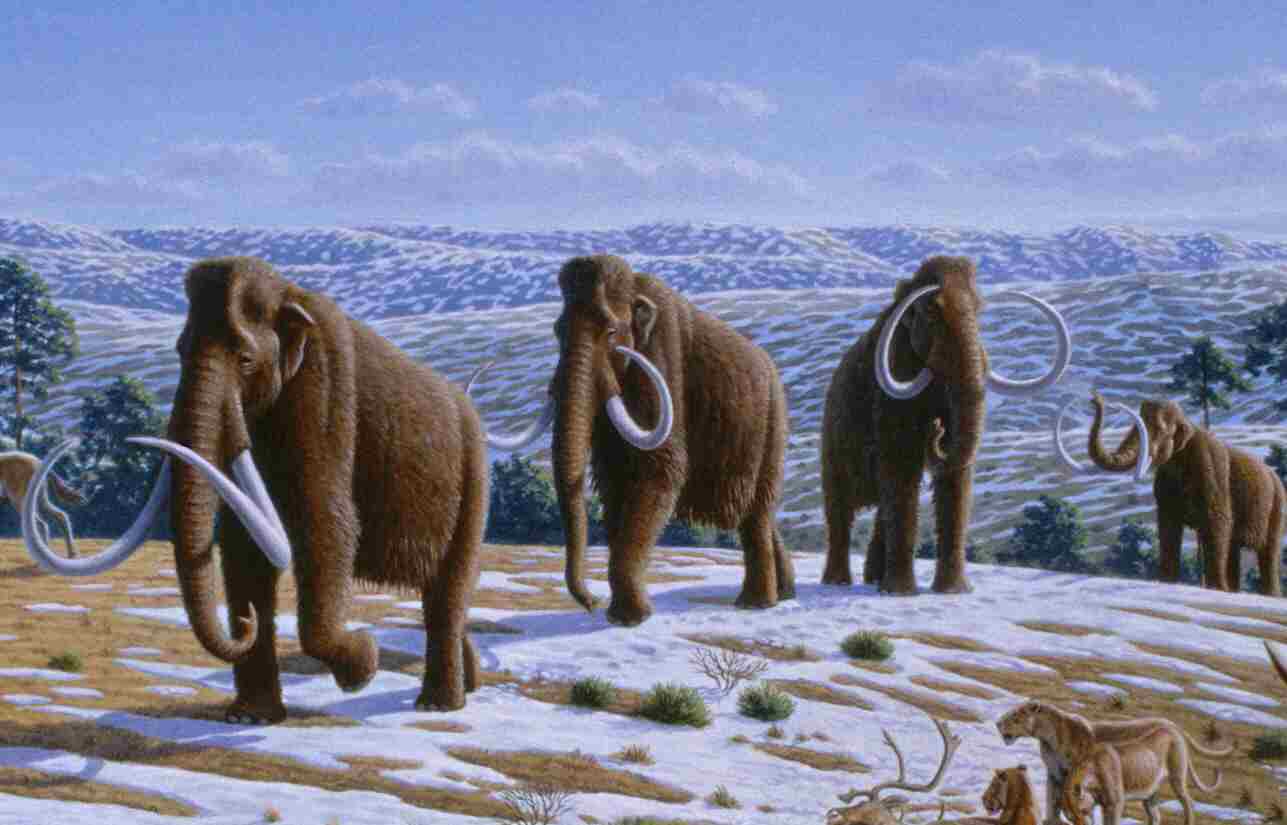 |
Hope of Israel Ministries (Ecclesia of YEHOVAH):
Earth Rings and Frozen Mammoths!
|
In II Peter 3:6, 7, 13, the apostle Peter talked about three worlds. The first is described in Genesis. We are living in the second world and it is to be followed by a third world -- described by Peter as, "a new heavens and a new earth." This article on the mammoths shows the effect of the first world transitioning to the present, and gives us a glimpse of what that first world was all about. |
by John D. Keyser
Most us have heard of the frozen mammoths whose perfectly preserved remains have been discovered in the Arctic regions. We have seen pictures of these furry giant elephants huddled together in the raging blizzard of a snowy plain, foraging through the snow to try to find sustenance. We have been told that they evolved their furry coats to help them survive the great Ice Age, and that from time to time one of them fell into a snow filled crevasse, or an icy river, where they became frozen and preserved in the state we find them today.
 |
Well, those are the MYTHS, now for the FACTS:
(1) The mammoths lived in a sub-tropical climate:
There is abundant evidence that the earth once enjoyed a uniformly warm climate. Coal seams in the polar regions show that lush forests once grew where now there is only snow and ice. A fallen 90-foot fruit tree, with ripe fruit and green leaves still on its branches, has been found in the frozen ground of the New Siberian Islands, where only 1-inch high willows grow now. Palm tree fossils have been found in Alaska. Grasses, bluebells, butter-cups and wild beans as fresh as the day they were eaten, have been found in the mouths and stomachs of the frozen mammoths.
The most famous, accessible, and perhaps studied mammoth is a fifty-year-old male, found in a freshly eroded bank, 100 feet above Siberia's Berezovka River in 1900. A year later an expedition, led by Dr. Otto F. Herz, painstakingly excavated the frozen body and transported it to the Zoological Museum in St. Petersburg, Russia.
 |
Much of the head, which was sticking out of the bank, had been eaten down to the bone by local wolves and other animals, but most of the rest was perfect. Most important, however, was that the lips, the lining of the mouth and the tongue were preserved. Upon the last, as well as between the teeth, were portions of the animal's last meal, which for some almost incomprehensible reason it had not had time to swallow. The meal proved to have been composed of delicate sedges and grasses.
Another account states that the mammoth's "mouth was filled with grass, which had been cropped, but not chewed and swallowed" (A. S. W., Nature, Vol. 68, July 30, 1903, p. 297). The grass froze so rapidly that it still had "the imprint of the animal's molars" (Lister & Bahn, Mammoths: Giants of the Ice Age, p. 74). Hapgood's translation of a Russian report mentions eight well-preserved bean pods and five beans found in its mouth (Charles H. Hapgood, The Path of the Pole, 1970, p. 267).
Twenty-four pounds of undigested vegetation were removed from the Berezovka mammoth and analyzed by the Russian scientist, V. N. Sukachev. He identified more than forty different species of plants: herbs, grasses, mosses, shrubs, and tree leaves. Many no longer grow that far north; others grow both in Siberia and Mexico. Dillow draws several conclusions from these remains:
o The presence of so many varieties [of plants] that generally grow much to the south indicates that the climate of the region was milder than that of today.
o The discovery of the ripe fruits of sedges, grasses, and other plants suggests that the mammoth died during the second half of July or the beginning of August (Joseph C. Dillow, The Waters Above: Earth's Pre-Flood Canopy, 1981, pp. 371-377).
Abundant food requires a temperate climate -- much warmer than northern Siberia today. Only a small percentage of the food found in Berezovka's mouth and stomach grows near the Arctic Circle today. Furthermore, the flower fragments in its stomach show that it died during warm weather. Despite the popular misconception, the mammoth was a temperate, not an Arctic, animal.
The artists -- who showed the mammoths living in snowy, Arctic regions -- were influenced by earlier opinions based on the mammoth's hairy coat, thick skin, and a 3.5 inch layer of fat under the skin. However, animals with these characteristics do not necessarily live in cold climates. Let's examine these characteristics more closely:
The mammoth's hairy coat no more
implies an Arctic adaptation than a woolly coat does for a sheep. The mammoth
lacked erector muscles that fluff-up an animal's fur and creates insulating air
pockets. Neuville, who conducted the most detailed study of the skin and hair of
the mammoth, wrote: "It appears to me impossible to find, in the anatomical
examination of the skin and [hair], any argument in favor of adaptation to the
cold" (H. Neuville, "On the Extinction of the Mammoth," Annual Report
Smithsonian Institute, 1919, p. 332). The long hair on a mammoth's legs hung to its toes. Had it walked in
snow, snow and ice would have caked on its hairy "ankles." Each step into and
out of snow would have pulled or worn away the "ankle" hair. All hoofed animals
living in the Arctic, including the musk ox, have fur, not hair, on their legs.
Fur, especially oily fur, holds a thick layer of stagnant air (an excellent
insulator) between the snow and skin. With the mammoth's greaseless hair, much
more snow would touch the skin, melt, and increase the heat transfer 10-100
fold. Later refreezing would seriously harm the animal.
The skin of the mammoth and elephant
are very similar in thickness and structure. Both lack oil glands, making them
vulnerable to cold, damp climates. Today, it appears that all Arctic mammals
have both oil glands and erector muscles -- equipment absent in the mammoths.
The amount of fat under the skin says little about an animal's habitat. Some animals living in temperate zones, such as the rhinoceros, have thick layers of fat, while many Arctic animals, such as reindeer and caribou, have little fat. Thick layers of fat under the skin simply show that food was plentiful. Abundant food also suggests a temperate climate.
The elephant -- a close approximation to the mammoth -- is a tropical, not an Arctic animal. It requires "a climate that ranges from warm to very hot," and "it gets a stomachache if the temperature drops close to freezing" (Ralph S. Palmer, "Elephant," The World Book Encyclopedia, Vol. 6, pp. 178, 178d). Newborn elephants are susceptible to pneumonia and must be kept warm and dry at all times. Hannibal, who crossed the Alps with 37 elephants, lost all but one due to cold weather.
A typical wild elephant requires about 330 pounds of food per day and spends about 16 hours a day eating. Therefore, vast quantities of food would have been required to support the estimated 5,000,000 mammoths that lived in just a small portion of northern Siberia. The Adams mammoth (a male), discovered in 1799, "was so fat...that its belly hung below its knees."
The average January temperature in northeastern Siberia is about -28 degrees F (60 degrees F below the freezing point)! During the ice age, it was colder. The long, slender trunk of the mammoth was particularly vulnerable to cold weather. A six-foot-long nose could not survive even one cold night, let alone an eight-month-long Siberian winter. For the more slender trunk of a young mammoth, the heat loss would be even more harmful. Elephants usually die if their trunk is seriously injured.
If the mammoth lived in an Arctic climate, its drinking water in the winter must have come from eating snow or ice. A wild elephant requires 30-60 gallons of water each day. The heat needed to melt snow or ice and warm it to body temperature would consume about half a typical elephant's calories. Unlike other Arctic animals, the trunk would bear much of this thermal stress. Nursing elephants require about 25% more water.
How would a mammoth that lives in an Arctic climate satisfy its considerable salt appetite? Elephants dig for salt using their sharp tusks. In the rock-hard permafrost this would be almost impossible, summer or winter, especially with the curved tusks of the mammoth.
The easiest and most accurate way to determine an extinct animal or plant's environment is to identify familiar animals and plants buried nearby. For the mammoth this includes rhinoceroses, tigers, bison, horses, antelope, a 90-foot-tall fruit tree, and temperate species of grasses. All live in warm climates. Some frozen remains are of burrowing animals, such as voles, who would not burrow in rock-hard permafrost. Even larvae of the warble fly have been found in a frozen mammoth's intestine -- larvae identical to those in tropical elephants today. No one argues that the animals and plants buried near the mammoths were adapted to the Arctic. Why then do so for the mammoths?
Clearly, the first world was one of a sub-tropical climate with lush foliage and abundant food for all.
(2) An estimated FIVE MILLION mammoths lie entombed in Arctic soils:
The soil of Siberia is so full of mammoth bones that ivory mines were working for many years, and at least 20,000 tusks were taken from one mine alone. Besides mammoths, the Arctic soils contain the remains of over 60 animal species, including the woolly rhinoceros. camels, horses, tigers, and antelopes. Many of them lie in frozen silt, mixed together with boulders and tree roots.
If we look for the bones and ivory of the mammoth, not just preserved flesh, the number of discoveries becomes enormous, especially in Siberia and Alaska. Nikolai Vereshchagin, the Chairman of the Russian Academy of Science's Committee for the Study of Mammoths, estimated that more than half a million tons of mammoth tusks were buried along a 600-mile stretch of the Arctic coast alone (John Massey Stewart, "Frozen mammoths from Siberia Bring Ice Ages to Vivid Life," Smithsonian, 1977, p. 68). Since the typical tusk weighs 100 pounds, this implies that more than five million mammoths lived in this small region. Even if this estimate is high and represents thousands of years of accumulated remains, we can see that large herds of mammoths must have thrived along the Arctic coast. Many more existed elsewhere. Mammoth bones and ivory are also found throughout Europe, North and Central Asia, in North America, and as far south as Mexico City.
This area of the Arctic coast may well contain the highest density of mammoth remains, since the rich New Siberian Islands lie offshore. The coastal zone of the Laptev Sea, which includes the western area of Vereshchagin’s estimate, is regarded as one of the largest mammoth cemeteries in the world.
Dense concentrations of mammoth bones, tusks, and teeth are also found on remote Arctic islands. Obviously, today's water barriers were not always there. Many have described these mammoth remains as the main substance of the islands. Even if these reports are exaggerated, what could account for any concentration and preservation of bones and ivory on barren islands well inside the Arctic Circle? More than 200 mammoth molars were dredged up with oysters from the Dogger Bank in the North Sea.
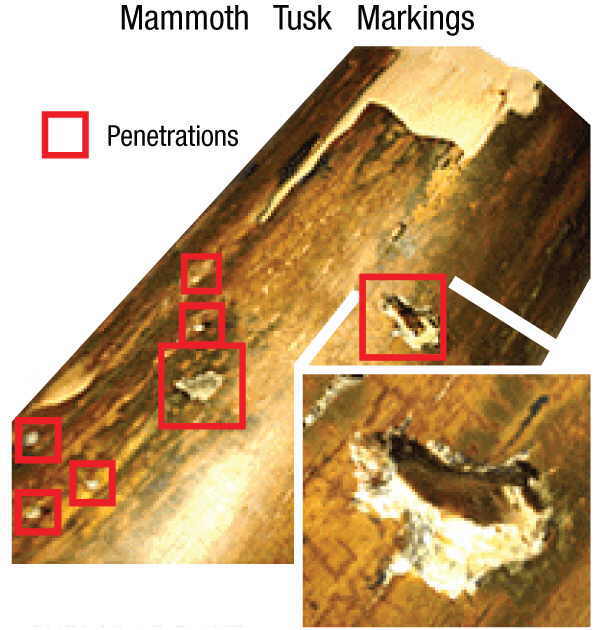
Peppered Mammoth Tusk. Scientists are finding, over wide geographical areas,
mammoth tusks embedded on one side with millimeter-size particles rich in iron
and nickel. The British Broadcasting Corporation stated, “Startling evidence has
been found which shows mammoth and other great beasts from the last ice age were
blasted with material that came from space.”
The number of woolly mammoths is more concentrated in northern Siberia. Mammoth remains are amazingly abundant on the Lyakhov Islands and on the other New Siberian Islands, 140 miles (230 km) north of the mainland. While the early report of one of the New Siberian Islands being totally composed of bones is an exaggeration, the many bones found on these islands indicate that Siberia and the adjacent continental shelves with their islands was once a vast plain dotted with woolly mammoths and other animals. Vereshchagin and Kuz’mina state:
"The shelf of the Laptev and East Siberian Seas [along the Arctic continental shelf] in some places…is covered with bones of horse, reindeer, bison, musk ox, and mammoth washed up by tidal waters. Occasionally, bones of wolf, brown bear, cave lion, and (rarely) woolly rhinoceros, moose, and saiga antelope are also found."
One can see that a wide diversity of animals accompanied the woolly mammoth in Siberia, as well as elsewhere across the Northern Hemisphere. This Ice Age environment has been called the mammoth steppe, which is a vast grassland.
Based on many reports, it appears that estimates of millions of woolly mammoths in the Siberian permafrost are correct. Lister and Bahn note that some scientists put the number at ten million mammoths in the Siberian deep freeze (Mammoths: Giants of the Ice Age). This makes the question of how they could have possibly found enough food and water in such a cold area even more enigmatic.
Woolly mammoth fossils are not only commonly found in Siberia, but they are also found in unconsolidated sediments all across the mid- and high latitudes of the Northern Hemisphere. Sometimes their remains are dredged up from the continental shelves in some locations. Although associated with the Ice Age, they are rarely found in previously glaciated areas. They are mostly found in non-glaciated areas of Siberia. They spread from Siberia into the non-glaciated portions of Alaska and the Yukon by way of the Bering Land Bridge. This land bridge was dry or mostly dry during the Ice Age. From the Yukon, the mammoths migrated through western Alberta by way of the ice-free corridor and spread south throughout the northern United States. The Columbian mammoth is usually found farther south -- in the southern United States, Mexico, and Central America. The number of woolly mammoth individuals fossilized worldwide probably exceeds 15 million.
(3) The mammoths (and other animals) were struck suddenly by an icy catastrophe:
An article in an old copy of The Readers' Digest Book of Strange Stories and Amazing Facts, reported that frozen-food experts had been asked their opinion on the frozen mammoths. Their verdict? "To deep freeze a huge living mammoth, insulated in thick fur...stupendously cold temperatures of below -101 degrees C. (-150 degrees F.) would be required. Such temperatures have never been recorded -- not even in the Arctic." The article goes on: "Apparently, at one moment the mammoth was munching away peacefully at the grass and butter-cups growing lush in the sunshine of a temperate plain. The next it was subjected to cold so bitter that it was deep frozen where it stood" (ibid.) Many of the frozen mammoths have been found in a standing position, surrounded by frozen silt. Their body tissues and stomach contents had not even begun to decompose.
Before examining other facts, we can see three curious problems. First, northern Siberia today is cold, dry, and desolate. How could thousands, if not millions, of mammoths and many other animals feed themselves? Apparently their surroundings were more temperate and moist. If so, why did the climate change?
Second, the well-preserved mammoths and rhinoceroses must have been completely frozen soon after death or their soft, internal parts would have quickly decomposed. Guthrie has observed that "an unopened animal continues to decompose after a fresh kill, even at very cold temperatures, because the thermal inertia of its body is sufficient to sustain microbial and enzyme activity as long as the carcass is completely covered with an insulating pelt and the torso remains intact" (R. Dale Guthrie, Frozen Fauna of the Mammoth Steppe, 1990, p. 84). Since mammoths had such large reservoirs of heat, the freezing temperatures must have been extremely low.
Finally, their bodies were buried and protected from predators, including birds and insects. But burial could not have occurred if the ground were frozen as it is today. Again, this implies a major climate change, but now we can see that it must have changed suddenly. How were these huge animals quickly frozen and buried -- almost exclusively in muck, a dark soil containing decomposed animal and vegetable matter?
Muck is a major geological mystery. It covers one-seventh of the earth's land surface -- all surrounding the Arctic Ocean. Muck occupies treeless, generally flat terrain, with no surrounding mountains from which the muck could have eroded. Russian geologists have in some places drilled through 4,000 feet of muck without hitting solid rock. Where did so much eroded material come from?
Oil prospectors, drilling through Alaskan muck, have "brought up an 18-inch long chunk of tree trunk from almost 1,000 feet below the surface. It wasn't petrified -- just frozen" (Anonymous, "Much About Muck," Pursuit, Vol. 2, pp. 68-69). The nearest forests are hundreds of miles away. Elsewhere, Williams describes similar discoveries in Alaska:
"Though the ground is frozen for 1,900 feet down from the surface at Prudhoe Bay, everywhere the oil companies drilled around this area they discovered an ancient tropical forest. It was in frozen state, not in petrified state. It is between 1,100 and 1,700 feet down. There are palm trees, pine trees, and tropical foliage in great profusion. In fact, they found them lapped all over each other, just as though they had fallen in that position" (Lindsey Williams, The Energy Non-Crisis, 2nd. Edition, 1980, p. 54).
How were trees buried under a thousand feet of hard, frozen ground? We are faced with the same series of questions that we first saw with the frozen mammoths. Again, we are driven to the conclusion that there was a sudden and dramatic change in climate accompanied by rapid burial in muck, now frozen solid.
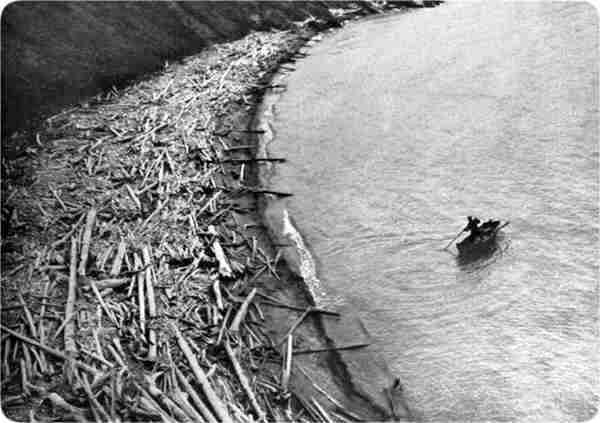 |
Fossil Forest, Kolyma River. Here, driftwood is at the mouth of the Kolyma River, on the northern coast of Siberia. Today, no trees of this size grow along the Kolyma. Leaves, and even fruit (plums), have been found on such floating trees. One would not expect to see leaves and fruit if these trees had been carried far by rivers. Why didn’t these trees decay?
Widespread freezing and rapid burial are also inferred when commercial grade ivory is found. Ivory tusks, unless frozen and protected from the weather, dry out, lose their animal matter and elasticity, crumble, crack, and become useless for carving. The trade in mammoth ivory has prospered since at least 1611 over a wide geographical region, from which an estimated 96,000 mammoth tusks have been exported. Therefore, the extent of the freezing and burial is wider than most people have imagined.
In May 1846, a surveyor named Benkendorf and his party were camped in Siberia on the Indigirka River. The spring thaw and the unusually heavy rains caused the swollen river to erode a new channel. Benkendorf noticed a large object bobbing slowly in the water. As the "black, horrible, giant-like mass was thrust out of the water [they] beheld a colossal elephant's head, armed with mighty tusks, with its long trunk moving in an unearthly manner, as though seeking something lost therein." They tried to pull the mammoth to shore with ropes and chains but soon realized that its hind legs were anchored, actually frozen, in the river bottom in a standing position.
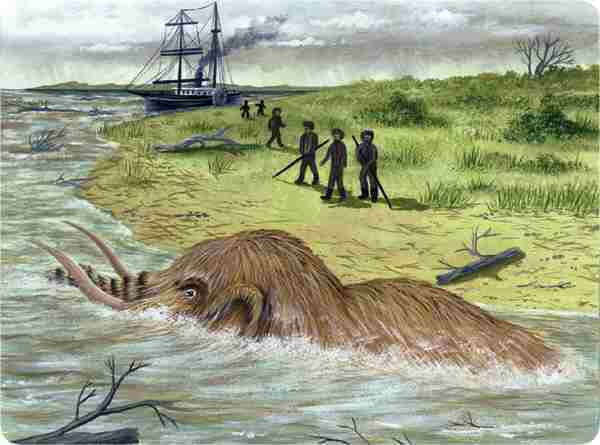 |
Twenty-four hours later, the river thawed and eroded the river bottom, freeing the mammoth. The team of fifty men and their horses pulled the mammoth onto dry land, twelve feet from the shore. The 13-foot tall, 15-foot long beast was fat and perfectly preserved. Its "widely opened eyes gave the animal an appearance of life, as though it might move in a moment and destroy [them] with a roar" (William T. Hornaday, Tales from Nature's Wonderlands, 1926. Translated from the Russian report). They removed the tusks and opened its full stomach containing "young shoots of the fir and pine; and a quantity of young fir cones, also in a chewed state..." (ibid.) Hours later and without warning, the river bank collapsed, because the river had slowly undercut the bank. The mammoth was carried off toward the Arctic Ocean, never to be seen again.
The mammoths must have been overwhelmed suddenly with a rapid deep freeze and instant death. The sudden death is proved by the unchewed bean pods still containing the beans that were found between the teeth of the Berezovka mammoth, and the deep freeze is suggested by the well-preserved state of the stomach contents and the presence of edible meat [for wolves and dogs].
At normal body temperatures, the stomach acids and enzymes break down vegetable material within an hour. What inhibited this process? The only plausible explanation is for the stomach to cool to about 40 degrees F in ten hours or less. But since the stomach is protected inside a warm (96.6 degrees F for elephants) body, how cold must the outside air become to drop the stomach's temperature to 40 degrees F? Experiments have shown that the outer layers of skin would have had to drop suddenly to at least -175 degrees F!
Independently, Sanderson concluded, "The flesh of many of the animals found in the muck must have been very rapidly and deeply frozen, for its cells [had] not burst...
"Frozen-food experts have pointed out that to do this, starting with a healthy, live specimen, you must drop the temperature of the air surrounding it down to a point well below minus 150 degrees Fahrenheit" (Ivan T. Sanderson, "Riddle of the Frozen Giants," Saturday Evening Post, Jan. 16, 1960, pp. 82-83).
(4) The mammoths covered a wide geographical area:
We should also notice the broad geographical extent over which these strange events occurred. They were probably not separate, unrelated events. As Sir Henry Howorth stated:
"The instances of the soft parts of the great pachyderms being preserved are not mere local and sporadic ones, but they form a long chain of examples along the whole length of Siberia, from the Urals to the land of the Chukchis [the Bering Strait], so that we have to do here with a condition of things which prevails, and with meteorological conditions that extend over a continent.
"When we find such a series ranging so widely preserved in the same perfect way, and all evidencing a sudden change of climate from a comparatively temperate one to one of great rigor, we cannot help concluding that they all bear witness to a common event. We cannot postulate a separate climate cataclysm for each individual case and each individual locality, but we are forced to the conclusion that the now permanently frozen zone in Asia became frozen at the same time from the same cause" (Henry H. Howorth, The Mammoth and the Flood, 1887, p. 96).
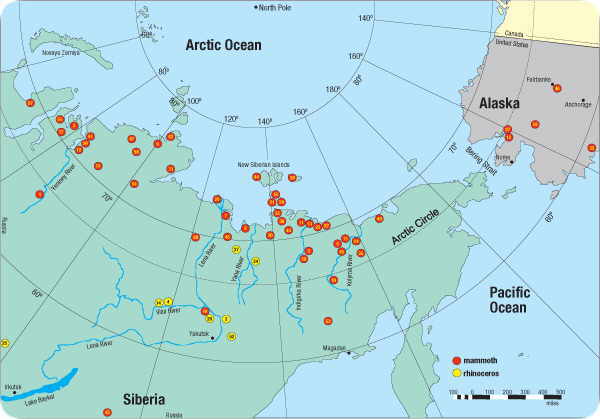 |
Actually, northern portions of Asia, Europe, and North America contain "the remain of extinct species of the elephant [mammoth] and rhinoceros, together with those of horses, oxen, deer, and other large quadrupeds" (A. G. Maddren, "Smithsonian Exploration in Alaska in Search of Mammoth and Other Fossil Remains," Smithsonian Miscellaneous Collections, Vol. 49, 1905, p. 87). So the event may have been even more widespread than Howorth believed.
Evolutionists, whose beliefs are based on gradualism (uniformitarianism), have no satisfactory explanation for the mystery of the frozen mammoths. To quote again from The Readers' Digest Book of Strange Stories and Amazing Facts: "Only a sudden cataclysm of hitherto on proportions could have been responsible." The greatest cataclysm of all time was, of course, the Biblical flood. This certainly explains how the mammoths were buried in silt, together with other animals, tree roots and boulders. But, what about the sudden freezing?
(5) The Collapse of the last Earth ring:
Since the times of Isaac Newton, Joseph-Louis Lagrange, Pierre Simon Laplace, Carl Friedrich Gauss and other great mathematicians of the Renaissance Era, there has been an inherent belief in the scientific community that the Earth is capable of retaining a stable ring system in orbit around it for millions of years.
In an article published by ex-NASA astronomer Dr. John A. O'Keefe in Nature magazine back in 1980, he hypothesized that the Earth once had a Saturn-like ring that could explain many of the events during past Earth ages. (Dr. O'Keefe is noted for discovering the Earth's slight pear-shape in the 1950s).
A Danish astronomer stated in Science Frontiers (Issue #76, Jul-Aug. 1991) that "in the past, the Earth had a ring system just like Saturn, Uranus and Neptune." He went so far as to say that our planet boasted rings on 16 separate occasions in the past.
As recently as September 2002, Sandia National Laboratories published an article by two University of New Mexico researchers who again reinforced the notion of past Earth rings. In that study, the authors supposed the existence of a thin system of rings -- perhaps of similar opacity to Saturn's B-ring -- may have caused past climatic changes on the Earth.
However, a pioneer in the concept of Earth-rings was Isaac N. Vail. In response to an article appearing in the Scientific American Mr. Vail wrote the following --
"To the Editor of the Scientific American:
"I have read with great interest in your issue of April 12 the note on the recent discovery of the body of a mammoth, in cold storage, by Dr. Herz, in the icebound region of Eastern Siberia. This, it seems to me, is more than a "Rosetta Stone" in the path of the geologist. It offers the strongest testimony in support of the claim that all the glacial epochs and all the deluges the earth ever saw, were caused by the progressive and successive decline of primitive earth vapors, lingering about our planet as the cloud vapors of the planets Jupiter and Saturn linger about those bodies today.
"Allow me to suggest to my brother geologists that remnants of the terrestrial watery vapors may have revolved about the earth as a Jupiter-like canopy, even down to very recent geologic times. Such vapors must fall chiefly in polar lands, through the channel of least resistance and greatest attraction, and certainly as vast avalanches of tellurio-cosmic snows. Then, too, such a canopy, or world-roof, must have tempered the climate up to the poles, and thus afforded pasturage to the mammoth and his congeners of the Arctic world -- making a greenhouse earth under a greenhouse roof. If this be admitted, we can place no limits to the magnitude and efficiency of canopy avalanches to desolate a world of exuberant life.
"It seems that Dr. Herz's mammoth, like many others found buried in glacier ice, with their food undigested in their stomachs, proves that it was suddenly overtaken with a crushing fall of snow. In this case, with grass in its mouth unmasticated, it tells an unerring tale of death in a snowy grave. If this be conceded, we have what may have been an all-competent source of glacial snows, and we may gladly escape the unphilosophic alternative that the earth grew cold in order to get its casement of snow, while, as I see it, it got its snows and grew cold.
"The above represents the earth stripped of its annular appendage and with its last lingering canopy suspended over the regions of both poles as vast clouds. Over the tropics and much of the temperate zones the vapors had become so thin that the clear sky could be seen at times in certain places. The sun shone into this thin vapor sky and made it a most brilliant illuminator. The sun itself was dimly seen in this effulgent heaven as a conquering hero waging victorious contest with vapor foes.
"During the igneous age the oceans went to the skies, along with a measureless fund of mineral and metallic sublimations; and if we concede these vapors formed into an annular system, and returned during the ages in grand installments, some of them lingering even down to the age of man, we may explain many things that are dark and perplexing today.
"As far back as 1874 I published some of these thoughts in pamphlet form, and it is with the hope that the thinkers of this twentieth century will look after them that I again call up the 'Canopy Theory'."
ISAAC N. VAIL.
Professor Vail further comments in Waters Above the Firmament --
"Taking a geologic view of the physical conditions of the earth immediately prior to the great revolution that swept the mastodon and a world of other huge pachyderms from existence, we are amazed at its apparent completeness. It would seem that if man were to be the resident of a perfect clime and to live and enjoy the immunities guaranteed by a greenhouse world, he might well have begun his career at that time. The great primitive elephant, almost a third larger than that of this age, luxuriated in regions now apparently the eternal home of the glacier. Tropical vegetation flourished under the very Arctic circle...the Canopy is a competent cause of such tropical conditions just as we now see one enveloping the planet Jupiter. Just such a Canopy must have embraced the Earth again and again before our oceans reached their home on its surface" (Stonehenge Viewpoint, Santa Barbara, CA 1988, p. 101).
These were the conditions that were extant from the time of Adam to that of Noah when catastrophe struck:
"But what closed this universal tropic scene? We see a great elephant frozen up in the Arctic snows. We find him embedded in great masses of solid glacier ice. We find his bones scattered profusely all over the north polar world, his carcass many times buried entire in the frozen soil. Some all-involving and sweeping catastrophe has fallen upon this once luxuriant land. I say luxuriant for these animals were struck down and buried on the spot where they roamed and fed. They have been found with the food in their stomachs undigested. They are found without the least show of transportation after death. The climate then was warm enough to support vegetation for their existence. Besides, all over the polar world where the feet of the explorer have trod are abundant proofs of a former vegetation now overwhelmed. Here and there is seen the wreck of forests. Trees swept by mighty floods into the Arctic Ocean and piled up into vast hills and frozen in mud and sand, speak of deluge and death. Sometimes, as on the northern parts of Alaska, submerged forests tell the tale" (ibid., p. 101).
Professor Vail goes on to explain the CAUSE of this tremendous change in the first world climate --
crushed them out of existence" (ibid.)."Let us surmise the cause of this stupendous change. I have intimated that Canopy vapors that fell in the polar regions must necessarily fall as snow. I need not dwell long on this circumstance for it would seem to be an evident necessity. Attenuated vapors high in the terrestrial heavens, though in the full glare of the sun must have been congealed even though they enwrapped a world of bloom. But when these fell in regions where the sun could have but little direct influence, as in the polar lands, snows must have accumulated beyond measure....The cause of a tropical climate must be the cause of its destruction. If a Canopy makes a greenhouse clime, that clime disappears only as the Canopy disappears. If Canopy vapors protected the huge quadrupeds of pre-glacial times, the fall of Canopy vapors
Continuing, Vail notes that
fell with a down rush and suddenness; that Canopy snows ONLY could do" (Ibid.)."the very condition in which these animals in the north polar world are found proves that they were destroyed by the accumulation of snows. That is, the pre-glacial animals were destroyed by the fall of the Canopy and the consequent accumulation of snows and the terrific impact of winter. In some instances the mammoth and Arctic rhinoceros have been found in the very snows of the Canopy times packed around them. Frozen in glacier ice that once fell as snow, they have remained in that condition since the very day of their death, since the very hour the snows broke in upon them, while on their forage ground. Immediately frozen up they have remained in their icy matrix till the day of their discovery. Their flesh is untainted after hundreds of centuries, and the very pupil of the eye is preserved. Some have particles of food lodged in their teeth. All these facts show that the snows that fell and entombed them have remained around them to this day. More than this: These facts show with a positive demonstration that the snows that entombed them
In the year 1874 Isaac N. Vail first published a pamphlet entitled The Earth's Annular System. Annular means having the form of rings, or ring-shaped, and has reference to successive rings or canopies of aqueous vapor which surrounded the earth and which fell upon the earth at different periods. A brief summary of the annular theory, as hypothesized by Mr. Vail, is given here:
1). The primitive earth was once a molten mass rapidly rotating through space.
2). The intense heat from the molten earth expelled all vapors, whether aqueous or metallic, and these were carried into the skies.
3). Both heat and centrifugal energy caused these vapors to accumulate in the skies, particularly in the equatorial region.
4). These red hot vapors contained all the fusible and vaporizable minerals known to the earth.
5). As the earth cooled, the heaviest of these vapors formed into rings nearest the earth and the lighter substances formed numerous other rings according to their weight and density.
6). These rings or belts were separate and well defined.
7). The rotation of these near the polar belts was slower than at the equator.
8). As these rings, formed of aqueous vapors and heavily laden with carbon, cooled down they rotated near the earth until they fell, the nearest and heaviest one falling first and leaving those more distant and lighter to move on in their respective orbits about the earth.
9). Each one of these rings, in due course, cooled and fell to earth.
Professor Vail then reasons that while all of these rings contained quantities of carbon, and other mineral substances expelled from the earth by the great heat, the last one of these rings was composed chiefly of water; that the light penetrating the ring or rings around the earth in due time caused this canopy, which enveloped the earth, to produce a hothouse condition -- thus making plants and animal life flourish at the poles equally with any other part of the earth; that these rings encircling the earth rotated more rapidly than the earth rotates upon its axis, but in time the cooling process would cause them to fall to the earth; and that the falling of the last one of these aqueous canopies occurred after man was created, and produced the great flood of Noah's time. The following is a quotation from Mr. Vail's The Earth's Annular System:
"All terrestrial waters were held in suspension during that age of inveterate heat, far removed from the surface of the boiling, flaming and smoking mass of the earth.
"This suspended ocean of vapors rotated as a part and parcel of the earth, a primeval atmosphere of great complexity of materials, in the same time that the earth then rotated, just as our present atmosphere now does.
"This suspended matter in the course of time gathered in the earth's equatorial heavens, and upon condensing necessarily contracted and segregated into rings, which revolved independently about the earth, thus causing a great lapse of time between the descent of the first, or primitive, ocean of water nearest the earth, and those waters most remote in the annular system.
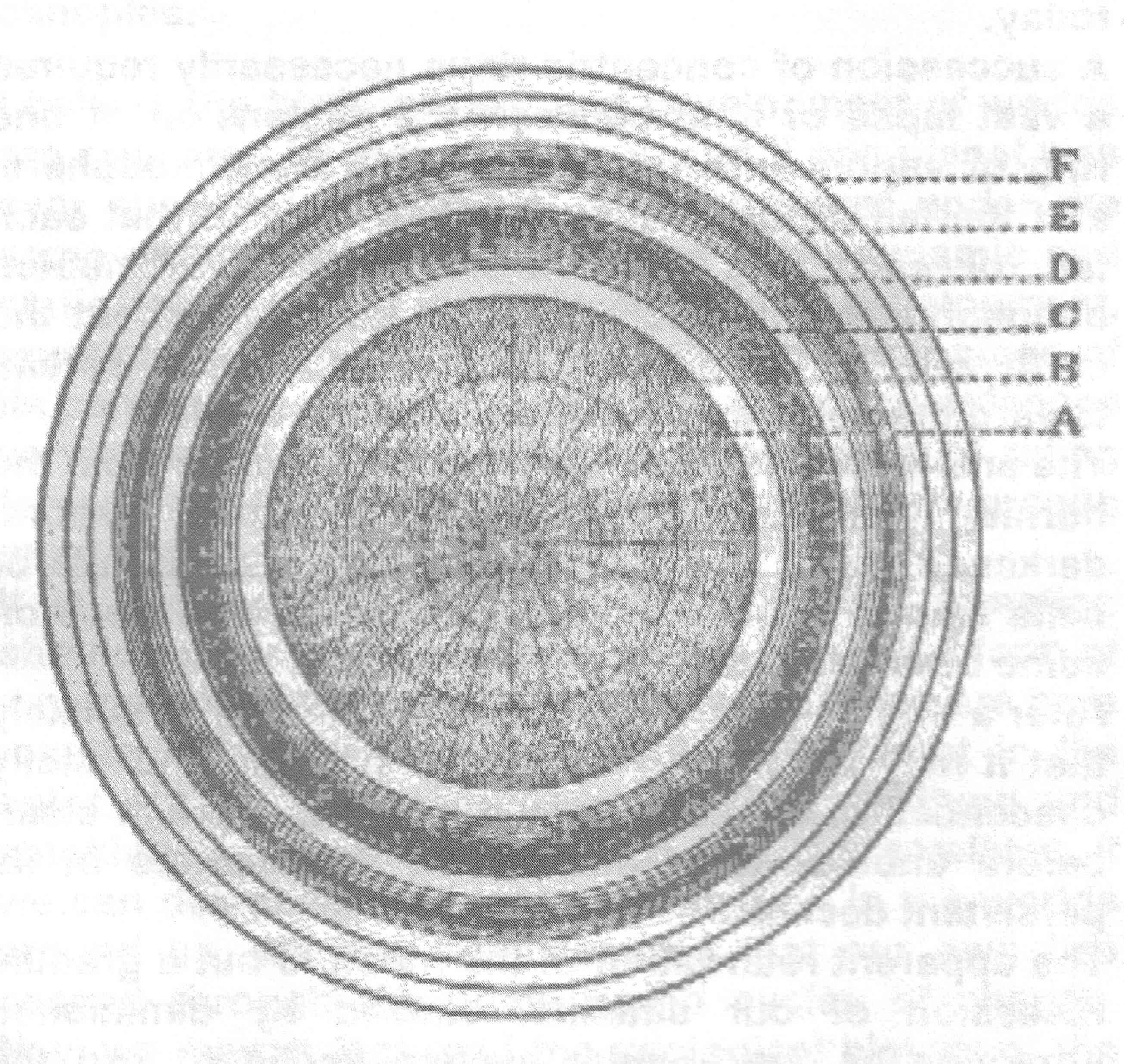 |
"This illustration [to the left] shows a full-face view of the earth and its annular system. Here A is the earth, B the earth's atmosphere, C the heavy carbons and their accompanying mineral sublimations, D the lighter carbons and hydro-carbons, E glacial snows and their accompaniments, F outer vapors, principally aqueous and likely in a frozen state. From this outermost ring came the polar snows that chilled the Eden earth, and afterwards caused the deluge.
"The waters remaining on high, after the interior waters or first ocean fell to the earth, fell in a succession of stupendous cataclysms, separated by unknown periods of time. The first ocean was necessarily impregnated with mineral and metallic salts, or filled with mineral and metallic particles, to a far greater extent than any other section or division of waters or exterior vapors, for the simple reason that in the system the heaviest vapors would settle lowest or nearest the earth as it cooled down.
"All such changes required a great length of time, and a progressive motion of declining matter from the equator, polar-wise; also the bands and belts of the earth's annular system necessarily presented the same general aspect that Jupiter's and Saturn's do today.
"A succession of concentric rings necessarily requires a vast lapse of time between the declension of one ring of vapors into the outskirts of the atmosphere, and the fall of the next succeeding one; so that each fall, or each ring, after it reached the attenuated atmosphere continued to revolve as a belt about the earth with an ever-decreasing velocity as it spread toward the poles and over-canopied the earth.
"The smoke or unconsumed carbon that arose from the burning world commingled with the upper vapors, darkened them, and formed inevitably dark bands or belts among bright vaporous ones, as we now see on some other planets.
"After a ring of vapors had fallen into the air, it is likely that it may have over-canopied the globe and finally descended to the earth, leaving the atmosphere clear, before another ring reached the atmosphere in its persistent decline.
"The apparent retardation of the moon is but a gradual recession of our satellite, caused by diminished attraction as the annular system declined; and the necessary check put upon the revolving rings necessarily caused them to sink and finally fall to the earth, if no other cause of their fall existed; and further, this retardation proves the former existence of an annular system about the earth.
"The Achaean metalliferous deposits are so located as to be inexplicable by the old theory of aqueous denudation, but beautifully in accord with the new.
"The Silurian beds, and particularly the order of their occurrence in the earth, utterly refute the idea that they were derived from pre-existing beds. Hence it is evident that during the Silurian age there was an annular system about the earth. In other words, it is evident that all the primeval waters did not fall before the dawn of life on the globe" (The Earth's Annular System, pages 72-74).
A very forceful argument is advanced by Mr. Vail to the effect that all planets are formed by universal or inexorable law; and since we now can see the rings surrounding Saturn, and can also see Uranus forming toward the uncompleted annular system, we must conclude that the earth also was developed by the progressive and successive collapse of aqueous canopies.
The birth, growth and development of worlds are regulated by inexorable laws of YEHOVAH God; and if one planet was ever surrounded by rings, a sister planet under the same circumstances, ruled by the same dynamic and static conditions of force, in process of development, must also be attended by rings during some stage of its career. Not that we should ignore the fact that circumstances must vary the resulting phenomena of ruling forces, but the great principles of planetary growth must be THE SAME on all planets.
It should be noted that while the vapors were being driven upward from the molten Earth, they would all tend to congregate over the equator -- or in that part of the atmosphere where the greatest force would drive them. As high as the atmosphere would be -- as driven by the force of heat expulsion -- the region of the equator would extend even higher because of the centrifugal force acting on the mass. With such a mass containing this energy of rapid rotation, very little of the Earth's original emissions would be left over the polar regions. As a result, in the formative period of the Earth's rings there was a general tendency for all of the vapors to pass from the polar regions toward the equator.
Now, when the Earth cooled down and the vapors began to return to the surface of the Earth,
this motion was reversed. The remaining vapor would begin to return first at the poles. With the absence of centrifugal force there, all falling matter would plummet toward the polar regions at a tremendous velocity -- following the path of least resistance.The regions of the Arctic and Antarctic circles would be those of the greatest annular downfalls, and from these regions the wreck of rings radiated over the Earth. With the collapse of the last ring canopy at these regions, the moderate temperatures of the pre-flood world at the poles plummeted in an instant -- enveloping anything that lived in a coffin of ice.
The speed of the freezing is vividly demonstrated by two reports that relate to the frozen mammoth problem. Each report was accepted as credible and published by an eminent scientific authority. Each involved the sudden freezing of a river in apparent defiance of the way bodies of water freeze. Each contained frozen animals in transparent ice, yet natural ice is rarely transparent. Each discovery was in a cold, remote part of the world. One was in the heart of Siberia’s frozen mammoth country.
The brief reports will be given exactly as they were written and translated. The first was published by the former Soviet Academy of Sciences. Alexander Solzhenitsyn, winner of the Nobel Prize for Literature in 1970, recalled this report (as best he could remember it) in the first paragraph of his preface to The Gulag Archipelago. Unfortunately, Solzhenitsyn did not give the report’s date, so a search had to be made for it. The report was finally found in Moscow’s Lenin State Library.
Y. N. Popov, author of this report, was discussing the scientific importance of finding mammals frozen in Siberia. He then described some frozen fish:
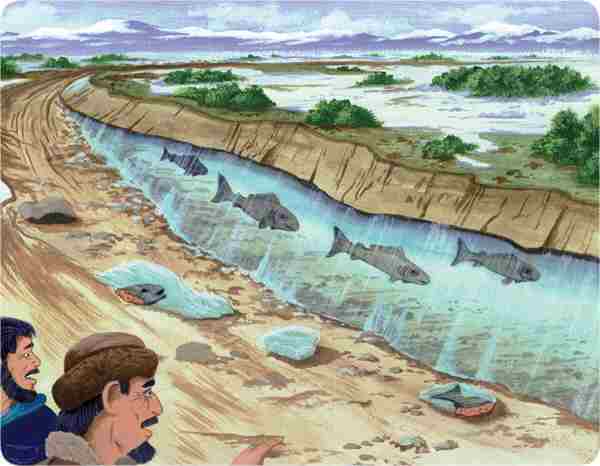 |
Fish Frozen in Underground Ice
"There are some cases of finds of not only dead mammals, but also fishes, unfortunately lost for science. In 1942, during road construction in the Liglikhtakha River valley (the Kolyma Basin) an explosion opened a subterranean lens of transparent ice encasing frozen specimens of some big fishes. Apparently the explosion opened an ancient river channel with representatives of the ancient ichthyological fauna [fish]. The superintendent of construction reported the fishes to be of amazing freshness, and the chunks of meat thrown out by the explosion were eaten by those present" (Y. N. Popov, “New Finds of Pleistocene Animals in Northern USSR,” Nature, No. 3, 1948, p. 76).
The second report comes from M. Huc, a missionary traveler in Tibet in 1846. Sir Charles Lyell, often called the “father of geology,” also quoted this same story in the 11th edition of his Principles of Geology. After many of Huc’s party had frozen to death, survivors pitched their tents on the banks of the Mouroui-Oussou (which lower down becomes the famous Blue River). Huc reported:
"At the moment of crossing the Mouroui-Oussou, a singular spectacle presented itself. While yet in our encampment, we had observed at a distance some black shapeless objects ranged in file across the great river. No change either in form or distinctness was apparent as we advanced, nor was it till they were quite close that we recognized in them a troop of the wild oxen. There were more than fifty of them encrusted in the ice.
Frozen Oxen Found in Tibet in 1846
No doubt they had tried to swim across at the moment of congelation [freezing], and had been unable to disengage themselves. Their beautiful heads, surmounted by huge horns, were still above the surface; but their bodies were held fast in the ice, which was so transparent that the position of the imprudent beasts was easily distinguishable; they looked as if still swimming, but the eagles and ravens had pecked out their eyes" (M. Huc, Recollections of a Journey through Tartary, Thibet [Tibet], and China, During the Years 1844, 1845, and 1846. Vol. 2 (New York: D. Appleton & Co., 1852), pp. 130-131).
Any explanation for these strange discoveries must recognize that streams freeze from the top down. The ice formed floats and then insulates the warmer liquid water below. The thicker the ice grows, the harder it is for the liquid’s heat to pass up through the ice layer and into the cold air. Freezing a stream fast enough to trap more than fifty upright oxen in the act of swimming across seems impossible, especially because a stream’s velocity varies considerably across its width. Therefore, different parts of the stream should freeze over many days or hours. Freezing a river so fast that large fish are frozen, edible, and underground, defies belief. However, the similarities with the frozen mammoths are so great that these reports are definitely related.
To freeze the fish and oxen in such a manner in bodies of water could ONLY have been accomplished by the incredible instant drop in temperature that accompanied the plummeting of the last Earth ring canopy over the polar regions of the Earth.
(6) Man and mammoth coexisted:
Mankind coexisted with the woolly mammoth and the other denizens of the pre-flood age. Writes George E. Lankford --
"Mammoths and mankind lived together in North America millennia ago. One human even carved the image of a mammoth on a shell...in the Delaware River Valley....one archaeologist urged the examination of Native American legends for examples of the retention of the mammoth in oral tradition" ("Pleistocene Animals in Folk Memory," Journal of American Folklore, Vol. 93, Issue 369. 1980, page 293).
In 1998 fossil hunter Neville Hollingworth uncovered mammoth bones and a flint axe in a gravel pit in Latton, Wiltshire, England. Some of the bones showed evidence of cut marks -- possibly caused by the flint axe found alongside the mammoth bones. During the next year ice gravel experts Daryl Maddy and Simon Lewis of Cheltenham and Gloucester College excavated more bones and several more hand axes indicating, once again, that mammoth and man coexisted at this time.
Mammoths and early man existed together. Archaeological evidence shows that woolly mammoths were butchered and men relished its flesh and chopped the ivory for making a framework for their dwellings and utility items for its durability and hardness.
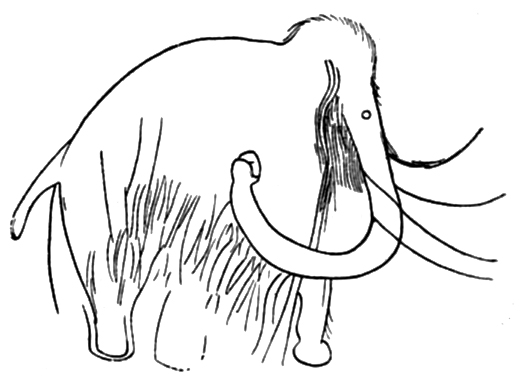 |
Woolly mammoth cave art from Dordogne, France
There are many figurines of animals and humans that early man crafted whether for religious or as a hobby is not known. Then came the collapse of the last earth canopy and the demise of vast numbers of these pre-flood animals.
With the pre-flood vapor canopy removed the earth's climate would never be the same again, and those creatures from the first world would remain preserved -- further evidence of YEHOVAH God's divine judgment. (See Genesis 7:11 and Isaiah 24:18-20.)
|
Hope of Israel Ministries -- Proclaiming the Good News of the Soon-Coming Kingdom of YEHOVAH God! |
|
Hope of Israel Ministries |
 |
Scan with your Smartphone for more information |